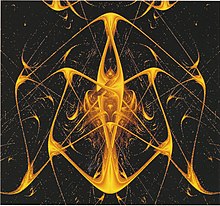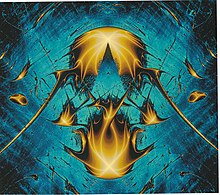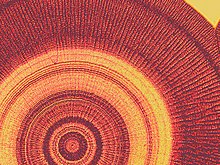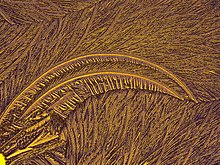User:Mario Markus/Mario Markus (Physicist)

Mario Markus (*born July 29 1944 in Santiago de Chile) is a German-Chilean physicist who worked for a long time in the Max-Planck Institute for Molecular Physiology in Dortmund. In addition to his scientific work, Markus has exhibited his own computer graphics, as well as written novels and poetry and translated spanisch poems. In numerous encounters with the media[1] he has followed his main concern of bridging the "two cultures", science and art.
Life[edit]
Markus was born to German parents in Chile. He attended the Liceo Manuel de Salas in Santiago and spent the school year 1961/1962 as an exchange student of the AFS in the USA. In early 1963 he passed his high school diploma in Chile. From 1963 to 1965 he first studied mathematics, biology, chemistry and physics at the Universidad de Chile and in 1965 switched to studying physics and mathematics at the University of Heidelberg, where he studied with the Nobel Prize winner Hans Jensen, among others.
In 1970 he obtained his physics diploma under Konrad Tamm at the Institute for Applied Physics at the University of Heidelberg with a thesis on the Pinch-Effekt in plasmas made up of electrons and holes in semiconductors. From March 1970 to 1973 he conducted research for his doctorate on instabilities in plasmas at this institute. At the beginning of 1973 he received his doctorate (Dr. rer. nat.). After working as an assistant at the Institute for Theoretical Physics at the University of Heidelberg, he moved to the Max Planck Institute for Biophysics in Frankfurt am Main in April 1974. From January 1975 he was a research associate at the former Max Planck Institute (MPI) for Nutritional Physiology (today's MPI for Molecular Physiology) in Dortmund in the department of the biochemist and biophysicist Benno Hess. In 1988 he habilitated at the University of Dortmund, where he was first appointed a lecturer and then, in August 1997, an associate professor.
Since 1993 he has headed his own research group at the MPI for Molecular Physiology. In 2004 he was elected Corresponding Member of the Chilean Academy of Sciences (Academia Chilena de Ciencias). Markus has published around 160 original scientific papers mainly on questions of self-organization and chaos in biology, physics and chemistry.
In addition to his scientific work, he has published several volumes of poetry, a novel, a comic and works on computer graphics.
Works and exhibitions with computer graphics[edit]
Since the 1980s, Markus has created numerous works and created exhibitions with computer graphics based on his novel representation of Ljapunow exponents (Ljapunow diagrams or Ljapunow fractals or Markus- Ljapunow diagrams). It should be noted, howeve, that many of these representations do not meet the mathematical definition of fractals, in which sections are similar or equal to the overall picture. The graphics were exhibited at the following locations, among others:
- DESY, Hamburg (1988)
- Goethe Institutes in Chile (Santiago, Valparaíso, 1988) and Portugal (Lisbon, Porto, 1992)
- University Gallery (Houston, Texas, 1989)
- Charité (Berlin, 1990)
- „Pop Maths Road Show“ in the UK (Leeds, Cardiff, Bristol, Plymouth, Bedford, Jodrell Bank, London, Glasgow, Edinburgh, Aberdeen, Liverpool, Sheffield, Cambridge, Stockport, Birmingham, 1989–1990)
In 2009 he published a comprehensive book on that subject with a CD-ROM for the reader to create such graphics. The german book “Die Kunst der Mathematik” (The Art of Mathematics) was also published in Spanish. Below are some examples of Markus Lyapunov diagrams that appear in that book.
Simulation of hallucinations / the "light at the end of the tunnel"[edit]

In 1994, Markus published a computational simulation ofHallucinations, which are caused by a lack of oxygen, among other things, and which resemble the “light at the end of the tunnel” that is sometimes described in near-death experiences. Markus writes:
"There is no doubt that the calculated concentric circles, spirals and tunnels are archetypal structures, as follows from well-known interviews conducted by Elisabeth Kübler-Ross with persons close to clinical death. Some of these persons had even been declared dead before their reports. She wrote several books about it. The visions of tunnels with a light at its end, which are described in these books and which are very similar to the available computer simulations, have been interpreted as 'evidence' of a path into the 'afterlife'. One of the arguments for this claim is that the visions are independent of the cultural or religious environment of the 'seers', giving the impression of being 'absolute'. In contrast, the results of the present work show that what all 'seers' have in common is not the 'afterlife', but the physiology of their brains." See: Mario Markus, “Hallucinations: their formation in the cerebral cortex can be simulated on the computer”
— Mario Markus, in „Halluzinationen: ihre Entstehung in der Hirnrinde kann im Computer simuliert werden“, [2]
2D Crystals[edit]
Markus discovered and described in detail a special type of crystal in the sense of "Ludic Science". They have been shown in several exhibitions in Dortmund, Berlin[3] and Heidelberg, among others, and have received positive feedback in the press. These 2D crystals are formed when microscope slides are wetted with a hydrophilic substance and allowed to dry. A drop of a chemical solution spontaneously spreads over the entire slide and crystallizes in a form that is completely different from known 3D crystals or monomolecular 2D crystals.[4] Examples of Markus’ 2D crystals are shown here below.
Prize for “Ludic Sciences”[edit]
Research projects are nowadays increasingly being funded or rewarded under the aspect of concrete applicability. However, there are many examples in past times in which fundamental discoveries were made through curiosity or through play. This applies, for example, to the beginnings of electromagnetism by Oersted and Faraday, among others. Mario Markus coined the term "ludic science" (Latin: ludus, the game). Examples of this can be found in his book “Ludische Wissenschaften”. In cooperation with the German Society of Chemists (Gesellschadt Deutscher Chemiker, GdCh) Mario Markus has offered an annual prize of 10,000 euros since 2022 for outstanding “ludic”scientific achievements. In order to finance the award, he leaves his house worth almost one million euros to the Gesellschaft deutscher Chemiker in his testament.[5][6]
Most important scientific findings with references[edit]
- First evidence of a chaotic biological clock
- Development of a cellular automaton for the rapid calculation of waves in excitable media, e.g. in the heart muscle and in other structures
- First evidence of turbulence in a chemical reaction
- Universal cellular automaton for calculating patterns on mussels and snails
- Method for stopping turbulence in excitable media (e.g. in the heart muscle) by wave-splitting with excitation pulses
- Simple experimental proof of double diffusive convection. This phenomenon predicts the impossibiliy of using drinking water from towed icebergs
- Modeling the periodic return of cicadas after a prime number of years
- Process for the complete separation of particles of different sizes by shaking
Prices[edit]
- Best Exhibition of the Year 1988 (“Estética en las Ciencias”), awarded by the Chilean Art Critics Association.
- Sponsorship award from the Chilean Ministry of Foreign Affairs for the publication of the bilingual audio book “Poesía Chilena” (“Chilean Poetry”, Sello Alerce, Chile, 2005).
Books[edit]
- Poemas de Invierno. Betania, Madrid 1990, ISBN 84-86662-60-5.
- Bilis Negra. (Comic) J.C. Sáez, Santiago de Chile 2006, ISBN 956-306-011-3.
- Charts for Prediction and Chance. Imperial College Press, London 2007, ISBN 978-1-86094-835-0.
- Punzadas. LOM ediciones, Santiago de Chile 2007, ISBN 978-956-282-924-3.
- Una fórmula = Una imagen. LOM Ediciones, Chile 2009, ISBN 978-956-00-0082-8.
- Die Kunst der Mathematik. Verlag Zweitausendeins, Frankfurt 2009, ISBN 978-3-86150-767-3.
- Poesía Latinoamericana. (Deutsch-Spanisch; Hörbuch; Sonderheft von Dichtungsring, Zeitschrift für Literatur. Nr. 37, 2009). ISSN 0724-6412.
- Poemas Químicos. LOM Ediciones, Chile, 2010, ISBN 978-956-00-0190-0.
- deutsche Ausgabe: Chemische Gedichte. Shaker Media, Aachen 2011, ISBN 978-3-86858-701-2.
- Chemical Poems. Dos Madres Press, United States, 2013, ISBN 978-1-933675-98-5
- Unsere Welt ohne Insekten : ein Teil der Natur verschwindet, Stuttgart : Kosmos 2014, ISBN 978-3-440-14336-0.
- Das nackte Gehirn : Wie die Neurotechnik unser Leben revolutioniert, Darmstadt : Theiss, Konrad / WBG 2016, ISBN 978-3-8062-3278-3.
- Stiche : Gedichte Spanisch – Deutsch, aus dem Spanischen übertragen vom Autor, mit einem Vorwort von Raúl Zurita, Leipzig : Lychatz Verlag 2016, ISBN 978-3-942929-37-0.
- (als Übersetzer): Chilenische Lyrik im bewegten 20. Jahrhundert, Rimbaud-Verlag 2016, ISBN 978-3-89086-351-1.
- Bildkraft der Substanzen: 2D-Kristalle zum Selbermachen, Arnshaugk-Verlag 2017, ISBN 978-3-944064-77-2.
- Ausgabe auf Spanisch: Scientia et Ars - La fuerza pictórica de cristales súper-planos, Ediciones UC, Chile, 2019, ISBN 978-956-14-2469-2.
- 222 Juden verändern die Welt, Hildesheim : Georg Olms Verlag 2019, ISBN 978-3-487-08607-1.
- Leben in den Eismonden?, München: Verlag Dr. Friedrich Pfeil, 2020, ISBN 978-3-89937-254-0.
- Exilneurose : Irrwege eines Physikers, Hildesheim, Zürich: Georg Olms Verlag 2021, ISBN 978-3-487-08637-8.
- Quallen: Ein Überblick, tredition, 2021, ISBN 978-3-347-40887-6.
- Ludische Wissenschaften, Pfeil-Verlag, München 2022, ISBN 978-3-89937-276-2.
as editor:
- M. Markus, S.C. Mueller und G. Nicolis, (Hrsg.): From chemical to biological organization, Springer-Verlag, Heidelberg 1988, ISBN 3-540-19264-6.
- A. Holden, M. Markus und H. Othmer (Hrsg.): Nonlinear Wave Processes in Excitable Media, Plenum Press, New York 1991, ISBN 0-306-43800-3.
- V. Pérez-Munuzuri, V. Pérez-Villar, L.O. Chua, M. Markus (Hrsg.): Discretely-coupled Dynamical Systems, World Scientific, Singapore 1997, ISBN 981-02-2912-7.
Weblinks[edit]
- Literature by and about Mario Markus/Mario Markus (Physicist) in the German National Library catalogue
- Homepage von Mario Markus
Einzelnachweise[edit]
- ^ "Pressestimmen" und "Populärwissensachftliche Vorträge" in www.mariomarkus.com
- ^ in: Adolf Dittrich, Albert Hofmann, Hanscarl Leuner (Hrsg.): Welten des Bewusstseins, Band 3: Experimentelle Psychologie, Neurobiologie und Chemie, Verlag für Wissenschaft und Bildung, 1994, ISBN 3-86135-402-0
- ^ Bericht über die Ausstellung am Max-Planck-Institut für Bildungsforschung, Berlin 2018 https://www.mpib-berlin.mpg.de/events/17032/97912
- ^ Markus: Bildkraft der Substanzen: 2D-Kristalle zum Selbermachen, Arnshaugk Verlag, Neustadt 2017, ISBN 978-3-944064-77-2.
- ^ siehe Synopsis of the book: “Ludische Wissenschaften” by Mario Markus, edited by Pfeil, Munich (2022)
- ^ https://www.gdch.de/gdch/preise-und-auszeichnungen/gdch-preise/mario-markus-prize.html

















